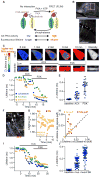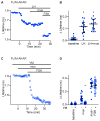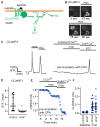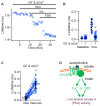Endogenous Gαq-Coupled Neuromodulator Receptors Activate Protein Kinase A
- PMID: 29154125
- PMCID: PMC5726796
- DOI: 10.1016/j.neuron.2017.10.023
Endogenous Gαq-Coupled Neuromodulator Receptors Activate Protein Kinase A
Abstract
Protein kinase A (PKA) integrates inputs from G-protein-coupled neuromodulator receptors to modulate synaptic and cellular function. Gαs signaling stimulates PKA activity, whereas Gαi inhibits PKA activity. Gαq, on the other hand, signals through phospholipase C, and it remains unclear whether Gαq-coupled receptors signal to PKA in their native context. Here, using two independent optical reporters of PKA activity in acute mouse hippocampus slices, we show that endogenous Gαq-coupled muscarinic acetylcholine receptors activate PKA. Mechanistically, this effect is mediated by parallel signaling via either calcium or protein kinase C. Furthermore, multiple Gαq-coupled receptors modulate phosphorylation by PKA, a classical Gαs/Gαi effector. Thus, these results highlight PKA as a biochemical integrator of three major types of GPCRs and necessitate reconsideration of classic models used to predict neuronal signaling in response to the large family of Gαq-coupled receptors.
Keywords: G protein-coupled receptor; Gαq signaling; acetylcholine; designer receptors; fluorescence lifetime imaging microscopy; hippocampus; muscarinic receptors; neuromodulation; optical reporters; protein kinase A.
Copyright © 2017 Elsevier Inc. All rights reserved.
Figures








References
-
- Airan RD, Thompson KR, Fenno LE, Bernstein H, Deisseroth K. Temporally precise in vivo control of intracellular signalling. Nature. 2009;458:1025–1029. - PubMed
-
- Allen MD, Zhang J. Subcellular dynamics of protein kinase A activity visualized by FRET-based reporters. Biochem Biophys Res Commun. 2006;348:716–721. - PubMed
-
- Allen Developing Mouse Brain Atlas. Allen Developing Mouse Brain Atlas. 2008.
-
- Armstrong DL. Calcium channel regulation by calcineurin, a Ca2+-activated phosphatase in mammalian brain. Trends Neurosci. 1989;12:117–122. - PubMed
MeSH terms
Substances
Grants and funding
LinkOut - more resources
Full Text Sources
Other Literature Sources
Molecular Biology Databases
Research Materials

